Appeal Hearings in Case 002/01 Resume
Today, February 16 2016, marked the first day of the resumed Appeal Hearings, after they had not taken place as scheduled in November last year following the non-appearance of national and international defense counsels for Nuon Chea. The Appeal Hearings are divided into six segments, two of which were covered today: the fairness of proceedings and the constitutionality of the Internal Rules and the overall approach of the Trial Chamber to the evidence. Both national and international Nuon Chea Defense Counsels denied to actively participate in the hearing, but were present in the court room. The Khieu Samphan Defense Team submitted that the proceedings in front of the Trial Chamber had been substantially and procedurally unfair and that consequently Khieu Samphan’s right to a fair trial had been denied. The Co-Prosecutors argued that the flaws that the defense team attempted to show were not infringing the accused’s right to a fair trial.
Introduction
At the beginning of the session, the Supreme Court Chamber Greffier read out the rules of conduct that applied during the hearing in the court room and in the public gallery.
The Supreme Court President Kong Srim then opened the resumption of the appeal hearings in Case 002/01. Both the Co-Prosecutors and the Defense Team had appealed the judgment. The Supreme Court Chamber Greffier confirmed the presence of all parties, except Nuon Chea International Defense Counsel Victor Koppe, who was absent “without any reason”. He then read the names of the Civil Parties who were present in the court room. Nuon Chea followed the proceedings from the holding cell downstairs.
The President explained that “the Chamber was forced to adjourn the hearing” when the appeal hearings were initially scheduled, since the International Counsel for Nuon Chea had not attended the hearing and National Counsel for Nuon Chea had not returned to the court room after the break. Subsequently, a stand-by counsel had been appointed, who was present in the court room today and who would take over in case that the National Defense Counsel walked out.
There were six sessions. The first five sessions concerned the appeals brought by Nuon Chea and Khieu Samphan. The last session related to the appeal by the Co-Prosecutors. In particular, the grounds of appeals in each session related to the
- Fairness of proceedings and the constitutionality of the Internal Rules
- Overall approach of the Chamber to the evidence
- Crimes for which the accused were convicted
- Individual criminal responsibility for which the accused were convicted
- Sentence imposed
- Appeal of the Co-Prosecutors
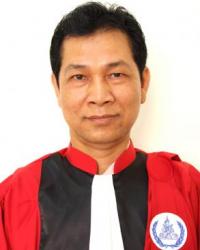
Supreme Court Chamber President Kong Srim
The President said that each session would start with the report of the Co-Rapporteur. He reminded the accused that they had a right to be presumed innocent. The President Kong Srim then announced that the Nuon Chea Defense Team did not wish to make more submissions. The Supreme Court Chamber had also received an e-mail yesterday which confirmed that the Defense Team did not intend to make any submissions. The Chamber informed Nuon Chea that this was “the last chance” to make submissions on the substance on the pending appeals. If Nuon Chea decided to change his approach, he would have to inform the Chamber at the beginning of each session.
The Co-Prosecutors had made a request to rely on additional authorities in their submissions. Since there had been no answer by the parties, the President asked them to react now. Khieu Samphan Defense Counsel Anta Guissé announced that they did not have any objection, but would like to be able to react in the session. The Civil Party Lead Co-Lawyers also had no objection.
1. ) Fairness of Proceedings and Constitutionality of Internal Rules
Submissions by the Khieu Samphan Defense Team
The floor was granted to the Khieu Samphan Defense Team. National counsel Kong Sam Onn started his submissions by saying that every accused had the right to a fair trial. The ECCC was supposed to be “a model court” for the international community and for Cambodia. He provided different sources for the rights of an accused for a fair trial. “Khieu Samphan was entitled to a minimum. He did not have it.” Ms. Sam Onn compared this court to the one of a show trial after the end of the Khmer Rouge regime. He said that the defense lawyers were seen by the chamber as “decoration” and said that “Khieu Samphan did not receive a real criminal trial. He did not have a fair trial.” This was “a shame” for the international community and for Cambodia. Mr. Sam Onn then gave the floor to his colleague Anta Guissé. She said that two years ago, she had urged the judges of the trial chamber to have a critical and impartial approach. This trial was not the trial of Khieu Samphan, but the one of a regime that had been defeated and condemned. In this sense, she said, Khieu Samphan had been condemned already. She pointed to “the irony of history”, in which the person who was seen as a symbolic representation of Democratic Kampuchea was also a symbol for unfair trials.
She compared the situation with the Tokyo Trials and said that this trial had “very disturbing similarities”. Both countries had suffered “massive bombardment” by the United States. Both countries had suffered immense internal difficulties. Both trials lasted for more than two years and both benches were international judges. The Tokyo Trials had been labeled as “cosmetic justice” and “no one dares” to refer to its jurisprudence. She said that she had to do the same for this trial. According to Ms. Guissé, the accused were “carefully chosen” in advance “in order not to disturb the government” in both countries. However, one difference was that the accused had the right to appeal the judgment, which was why the parties were present today in front of the Supreme Court Chamber. “The facts are serious. The facts are painful”. The application of the law had to be applied with “objective serenity”, which was not the case in front of the Trial Chamber according to Ms. Guissé. She further said that the judgment was conducted “in total confusion”, as was the whole trial. She said that Khieu Samphan “had to be convicted”, and that this was the goal of the trial. “The means justified the ends”, she criticized. All the breaches taken collectively made it impossible for a fair trial to have taken place in front of the Trial Chamber.
Ms. Guissé further submitted that the Chamber had violated international standards. The severance of the case was also “not practical”. The Trial Chamber had sought evidence outside the scope of the trials.
The judgment relied on timing that was also outside the jurisdiction of the court because of the temporary jurisdiction. She acknowledged that it was important to give context, but it was important to adhere to the temporary jurisdiction. The Trial Chamber should have relied on the international experience with trials.
She then referred to a key witness of case 002/01 (Rochoem Ton alias Phy Phuon, testimony of 1 August 2012), who was the only one who said that Khieu Samphan had attended a meeting, in which the evacuation of Phnom Penh had been discussed and decided. When this witness was confronted with inconsistencies in his testimony, counsel had been restricted by the President to ask “disturbing questions” and not to intimidate the witness. The defense counsel was to wait for the final submissions. Comparing this to witness So Socheat (TCW-673, wife of Khieu Samphan), she said that this witness had not “enjoyed the protection” of the Chamber, since she gave exculpatory evidence.[1] She said that Judge Jean-Marc had not acted neutrally and rather acted like a partial Prosecutor. Ms. Guissé said that this was a turning point for the Defense Team, since it showed the double standards of the trial chamber.
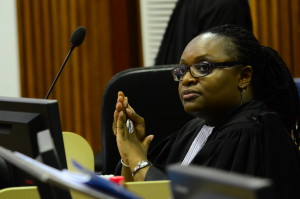
International Khieu Samphan Defense Counsel Anta Guissé (ECCC: Flickr)
Ms. Guissé then referred to Judge Cartwright and a conference she had given. Judge Cartwright had spoken in front of the Aspen Institute and talked about the political context of Democratic Kampuchea.[2] She had also said that the regime had been “atrocious” and that she had heard some Cambodian colleagues “grumble” to disagree with certain statements. She had also said that the “most important” part was to “fight impunity”. Ms. Guissé said that this seemed to indicate that fighting impunity was more important for the chamber than the fair trial rights. Thus, she argued, having three Cambodian judges who had experienced the Democratic Kampuchea regime, one New Zealand judge whose goal was to “fight impunity” and one judge who acted like a Prosecutor, a fair trial was impossible.
The Trial Chamber had also refused to put an excerpt of the book by Marcel Lemonde (a former Co-Investigating Judge) on the case file.[3] He had explained that some witnesses should have been called but were not and that he had not been able to obtain access to the CIA file about Cambodia. Not admitting this excerpt was detrimental to the fair trial.
The President reminded the Defense Counsel that she ran out of time.
Ms. Guissé said that she requested from the Supreme Court Chamber that they apply fair trial standards.
Submissions by the Co-Prosecutors
At the beginning of the next session, National Co-Prosecutor Chea Leang was given the floor. She submitted that this appeal related to the evacuation of Phnom Penh, another evacuation, and the “massacre of Lon Nol officials”. She said that a team of experienced lawyers represented the accused. All parties were given the opportunity to provide evidence as well as challenge the evidence submitted by others. She said that Nuon Chea had said that he had been prevented to present “his side of the story” and said that he had had “every opportunity” to present his views, but had exercised the right to be silent instead. Moreover, his side had been found unconvincing. The evidence of the “guilt of the appellants” was “overwhelming” in her view. His goal was to use the trial as a “political theatre”. She believed that the ECCC served two purposes. In her view, it
- Demonstrated that those responsible for the gravest crimes could not escape responsibility; and
- Taught Cambodians and the rest of the world that a just society was based on the rule of law, and that all persons were entitled to a fair process – both victims and the accused.
She said that she was struck by Nuon Chea’s speech in November, which showed that he acknowledged the importance of fair trial – a right that had not existed under the Khmer Rouge. The evidence provided did not bring any exoneration for the accused, but instead further confirmed his guilt. In his appeal brief, Nuon Chea had asserted that “no living being” was more responsible for the evacuation of Phnom Penh than Heng Samrin. However, he had admitted beforehand that he and other cadres had planned the evacuation. She alleged that Heng Samrin was “not even present” during this early April 1975 meeting. Nuon Chea had emphasized the notes of an interview of Heng Samrin conducted by Ben Kiernan. In those notes, Heng Samrin had said that Nuon Chea had instructed the cadres to “komchat” the Lon Nol officials. She translated komchat as to eliminate or to get rid of. In this context, it meant to kill these people. She queried why Nuon Chea requested Heng Samrin as a character witness, since Heng Samrin could merely show Nuon Chea’s dedication to the revolution.
He had also requested to admit evidence that had been obtained through torture. “This apparently is a key part of Nuon Chea’s story”: evidence that had been obtained through starving people, humiliating them and mistreating them.
The defense teams had been given “extensive opportunity” to examine witnesses, present evidence, challenge other evidence and present their arguments. “The defense team failed, not because the Trial Chamber was unfair, but rather because the evidence showed that these crimes were committed and that both Nuon Chea and Khieu Samphan played key roles making them criminally responsible for the suffering that resulted. Their trial was fair and their convictions justified by the evidence.”
She then gave the floor to her international colleague William Smith. Mr. Smith said that Nuon Chea had not made a response to the brief made by the Co-Prosecution. He submitted that the arguments made in the 300-page brief showed that the arguments submitted by the defense teams about unfair trial proceedings were not substantial. He said that using analogies and metaphors, such as referring to the Tokyo Trials without actually demonstrating the similarities, were not substantive arguments. Incidents of an 18-month trial did not show the partiality of the Chamber. Phy Phuon was, in Mr. Smith’s view, one of the most credible witnesses. As for the questioning of Judge Lavergne, he submitted that the judge needed to be convinced – since this was not a common law system, judges had a more active role. As for the conference given by Judge Cartwright, he explained that she had given this conference after hearing evidence, and not prior to this. Thus, the defense submitted that something she said after hearing the evidence showed the bias she had already prior to hearing evidence. Referring to Judge Lemonde, Mr. Smith said that this was not to measure whether the Trial Chamber was not acting in an unbiased way.
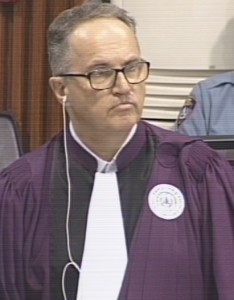
International Deputy Co-Prosecutor William Smith
In the brief, the Defense Team had only cited a “handful” of decisions that they submitted to be unfair. Mr. Smith said that it took more than a handful of decisions to show the bias of a chamber.
Mr. Smith turned to the argument that the trial had dealt with facts outside the temporary scope of the chamber. He referred to the ICTR Nahimana case and said that the drafters of the statute there wanted specifically only acts that fell within a four months period prior to acts included. This, Mr. Smith said, was not the case at the ECCC statute – the drafters had not expressed that they wanted acts to be excluded that took place after January 1979. He said that accused can only be convicted of those that they were aware of and could defend themselves again. Mr. Smith said that this was the case, and that the fundamental right to know what the accused was charged of, was respected.
Judge Agnieszka Klonowiecka-Milart interjected and said that the Chamber would be interested in hearing arguments on the appeal argument that they were deprived of using particular evidence that was yet used by the Trial Chamber later. Mr. Smith requested five more minutes to finish his submissions, which were granted.
Mr. Smith continued his submission and said that Nuon Chea knew about the charges in October 2012. The transcripts of the trials showed “consistently” that he was “well aware” of the charges. He was not convicted of anything more than what he was aware of. The Khieu Samphan team had never challenged this, and yet now submitted that they had not been aware of all charges. To show that the Judges interrupted the defense team’s questioning on a few occasions – since the questions were repetitive or irrelevant – did not show that the trial was unfair. Moreover, the chamber had provided thirty days that only related to evidence without experts, civil parties or witnesses being questioned, in which the defense had ample opportunity to challenge the evidence. The Khieu Samphan team had not shown that the effect of errors compounded on each other to invalidate the judgment. He argued that the Trial Chamber went “through great length” to make sure that this trial was fair. Even if one or two of these alleged errors actually occurred, which the Co-Prosecution submitted that they had not been unfair, these did not make the judgment unfair on a cumulative basis. Thus, Mr. Smith argued that the judgment “was absolutely and fundamentally fair”. With this, Mr. Smith finished his submissions.
The President gave the floor to the Rapporteur to open the next session.
2.) Grounds of appeal related to the overall approach to evidence
The Rapporteur summarised the grounds of appeal related to the overall approach to evidence:
- Allegation that the Trial Chamber erred by limiting opportunities for investigations and that the investigations were not conducted properly. The investigations were flawed by procedural irregularities that were not corrected by the Trial Chamber by preventing the Defense Team from carrying out their own investigations;
- Allowing the witnesses to review their previous statements and to confirm their statements. The Trial Chamber had limited their questioning to clarifying a few matters.
- Violation of the accused’s rights to confront evidence against them
- Trial Chamber’s reliance on out-of-court statements. Nuon Chea and Khieu Samphan submit that it erred in the standards it applied, such as statements collected in Written Record of Interview, victim complaints and civil party applications. The Trial Chamber had not argued
- Trial Chamber’s decision to rely on the testimony of Civil Parties, specifically Victim Impact Testimonies and Statements of Sufferings. Low probative value
- Testimony of witnesses. Errors in probative value of witnesses and experts
- Treatment of hearsay evidence, and application of beyond-reasonable doubt standards. Challenged that torture tainted evidence was inadmissible
At this point, the Supreme Court Chamber President adjourned the hearing for a break.
At the beginning of the next session, the President announced that the Khieu Samphan Defense Team had sent an e-mail to request the admission of several authorities in front of the chamber. Ms. Guissé explained that they requested to use the documents in session number 3 about the crimes. Neither the Co-Prosecutors nor the Civil Party Lead Co-Lawyers objected. The documents were admitted. The floor was then granted to the Khieu Samphan Defense Team relating to grounds of appeals on the overall approach of evidence.
Positions by the Khieu Samphan Defense Team
Ms. Guissé said that she had indeed showed unfairness of the judgment. She claimed that the judgment was a result of “distortion and confusion; Distortion of the rules and contempt of the rules.” She referred to a dissenting opinion of Christine Van den Wyngaert of the Katanga judgment and said that this judge had pointed out that the intime conviction could not stand up against the standard of proof and the “dispassionate rigor” it demanded.[4] She said that the Judges had to adhere to certain rules when exercising their discretion in light of intime conviction, that is that
- The decisions should be reasoned
- Assessment and administration of evidence: doubt must always benefit the accused
She said that the judges had not respected this rule. Next, she referred to case law to show that when the evidence allowed drawing more than one reasonable finding, it had to be ruled in favor of the accused .She argued that this principle had not been respected.
She pointed to paragraph 202 of the brief, in which they had said that doubt must always benefit the accused. Moreover, the fairness of proceedings also related to the assessment of the evidence and not only in the opportunity to present evidence. This was not only a question of distortion of evidence, but also a question that the Chamber relied on evidence that had low probative value. Moreover, they had relied on expert witness testimonies. She said that many factual errors had been made by the Trial Chamber. As an example, she cited the two Written Records of Interviews that the Trial Chamber had relied upon to determine the active participation of Khieu Samphan in some meetings of the Standing Committee, while other Written Record of Interview did not show this.[5] She asked why he was never designated a standing member of the Standing Committee if he had as much power as the Trial Chamber alleged. She reminded the Chamber that there was no other testimony, and the Chamber had not taken into account other accounts from security guards of the meetings who had explained that they were situated at a distance of the meeting and could therefore not see what happened.
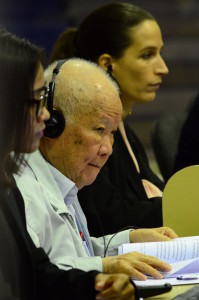
Co-Accused Khieu Samphan (ECCC: Flickr)
She argued that the Chamber had to actively seek information to corroborate the information they sought to confirm. Thus, they had preconceptions that they attempted to confirm. The Chamber had said that the meeting was set in a way so that Khieu Samphan could present results. However, it was not clear where this presumption came from. Moreover, neither Nuon Chea, nor Ieng Sary, had said that they were present in the meeting. Phy Phuon had talked about two meetings, while the Trial Chamber had only referred to one meeting, since “it suits the Chamber to do so”. Thus, there was “a problem with the management of the evidence.” It was also said the Khieu Samphan was present at education meetings that served to indict hatred. However, they failed – according to Ms. Guissé – to quote Phy Phuon, who had said that Khieu Samphan promoted the union of citizens.
1399 written statements had been admitted on 15 August 2013. This was shortly before they were drafting their final brief. Moreover, there had been statements made by Civil Parties that showed “an enormous gap” between the written statements and “what was said here” by the Civil Parties. “But okay, we base ourselves on that in order to sentence Khieu Samphan” for the forced population movements. For example, she argued that Sam Sithy told the Court a different story when he came to testify than what was in his written statement. As for the Civil Parties, she said that albeit not having the same position as the Nuon Chea team, they did say that there was “an issue” with the Chamber’s management. There were two types of hearings: first, those in which Civil Parties were questioned as any other witnesses, and second when Civil Parties testified on the effects of the crimes and the sufferings. The Chamber had made a difference between a Civil Party statement and a normal statement. During the statement of suffering, limited time was granted to the defense teams to question. Thus, the Chamber based itself on the statements of suffering despite the method that this was obtained through.[6] She could, she said, talk about the “lack of thoroughness” and the experts, but since she did not have time, she hoped to be able to explain this when questions were put to her by the Judges.
She claimed that the accumulation of distortions was infringing fair trial rights. She asked the Chamber to “sanction this”. It was important to demonstrate “dispassionate rigor”. With this, she finished her submission.
Submissions by the Civil Party Lead Co-Lawyers
The floor was given to the Civil Party Lead Co-Lawyers. National representative of the Civil Parties Pich Ang said that all the points raised by the Co-Prosecutors were valid. The Civil Party lawyers’ submissions were meant supplementary. The Civil Party applications were admitted as evidence. They were considered by the Co-Investigating Judges and determined to be credible. All parties were aware since that time that the Civil Party applications would be used as evidence. Moreover, parties had the opportunity to object to documents and use these to confront witnesses. These Civil Party applications were used in corroboration with other evidence.
The Defense Team for Nuon Chea had alleged that the Civil Party lacked the safeguard to preserve probative value of evidence, since they were allowed to meet with their lawyers and did not have to take an oath. As for the latter, Mr. Ang said that Civil Parties were a party to the case and could speak before the Chamber. This was decided on several occasions by the Chamber in August and November 2011 and in 2013. This also resonated French law. Their testimony could be used as evidence in front of the Chamber. The credibility of the Civil Party applications and documents had to be examined on a case by case basis. He then argued that the Defense Team for Nuon Chea had alleged that the arguments were made that Civil Parties were on the same level as witnesses. He said that Civil Parties were not witnesses and might have different interests from witnesses. They could attend cases on all stages of the proceedings. He claimed that the Chamber had not erred in law in the way the credibility of the Civil Party testimonies were assessed. “The testimony of Civil Parties may be questioned for clarification against the Civil Parties, and of course it is up to the discretion of the bench to consider their testimony on a case by case basis.” He pointed out that the Nuon Chea erred in saying that Civil Parties should not be asked about facts, since all parties had opportunity to question the Civil Parties.
He then gave the floor to his international colleague. Marie Guiraud said that the defense had sufficient opportunity to challenge the evidence provided by Civil Parties. They could have challenged the admissibility, the tendering into evidence and the credibility. Both accused had challenged the manner that the Chamber used the evidence provided for by the Civil Parties. None of the accused demonstrated how alleged errors showed how this made the judgment unjust or how this presented a miscarriage of justice. Thus, all appeal grounds had to be rejected. The evidence was “very often” in written. Given the limited number of Civil Parties who were able to testify in front of the course, it was crucial to admit the Civil Party applications into evidence, since this presented the only way how to make their participation meaningful and real. Civil Party applications included detailed accounts of what a person endured during Democratic Kampuchea regime. Some Civil Parties filled out the documents by themselves; others were assisted by NGO’s or the Victim Support Section. These documents were assessed by the Co-Investigating Judges with regards to their probative value. The defense had access to that record from the very beginning. Trial Chamber issued a decision, in which it had said that the right of the accused to confront a Civil Party Application was central and that the Civil Party Application had to be made available in all three languages of the Court.[7] They would be forbidden if they “had to do” with the acts and conducts of the accused, since no confrontation was possible. They limited the number of Civil Party Applications that they tendered into evidence (out of a number of 3867, they tendered into evidence 484 applications). The Defense Teams had opportunity to object to the admissibility and the probative value of these.[8] The Judgment explained in paragraphs 34-39 the criteria that it had taken to evaluate the probative value.
- The circumstances under which the Civil Party Application was collected
- The possibility to confront these statement
Ms. Guiraud said that it was “up to the Supreme Court Chamber” to consider this matter and whether this assessment had been correct. At this point, the President adjourned the hearing for a break.
Submissions by the Co-Prosecutors
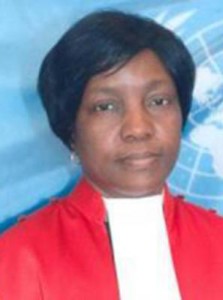
Judge Florence Ndepele Mwachande Mumba (ECCC)
After the break, the floor was granted to the Co-Prosecutors to make their response regarding the overall approach to evidence. Mr. Smith said that counsel had defined the Trial Chamber’s approach to evidence was “distorting”, while it was clear that counsel herself had distorted evidence with regard what was available to the Chamber. As an example, in relation to the statement that there was no live testimony in relation to the population movements prior to 1975, this was “simply not correct”. The witnesses Ponchaud, Heder, Duch and Nou Mao had all given evidence related to this.
He referred to the Trial Chamber decision of 20 May 2013, in which it had set out that the parties may question Civil Parties with relating to acts that were linked to the crimes. At the time, the Khieu Samphan counsel had not rejected this argument.
“It’s completely false […] to assume that this case was made or built on written statements without the opportunity to cross-examine the issues that arouse out of these statements.” There were 5,800 documents that amounted to 220,000 pages that provided probative value, out of which 2,800 originated from Democratic Kampuchea. Under 20 percent of the documents the Chamber relied upon relied on Written Records of Interviews without the opportunity to cross-examine. More than 200 statements were available on the Case File by the accused that went to proof the evidence. More than 80 percent were produced by the CPK itself. There were 495 copies of telegrams and reports from the zones, 345 public statements from the government, 58 minutes of CPK meetings, out of which 16 indicated that Khieu Samphan was present. There were 86 CPK Publications relating to the policies of the government that were coming out during the period (Revolutionary Flags and Magazines). Thus, the Trial Chamber had looked at the evidence in terms of totality, which was the right thing to do in Mr. Smith’s view. The documents should not be seen individually to determine whether the Prosecution had proved its case beyond reasonable doubt. “You lose the forest for the tree, if you look at one point” and look whether this proofs it beyond reasonable doubt. The Chamber had looked at the right criteria to proof beyond reasonable doubt the guilt of the accused. With this, Mr. Smith concluded his submissions.
Questions by the Bench
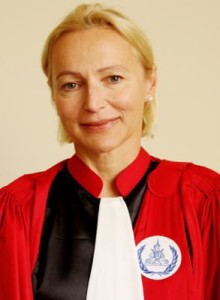
Judge Agnieszka Klonowiecka-Milart (ECCC)
The floor was then handed to the bench to put questions to the parties.
Judge Klonowiecka-Milart asked whether the Prosecution would defend the judgment that it entailed little – if any – discussion on the reliability of evidence and witness credibility in the judgment. Mr. Smith said that he would indeed defend this,
since they had stated that the accused had all opportunity to confront the evidence, which should be assumed to also apply to the witness statements. Moreover, the Chamber had consistently showed that they adhered to the principle that “The accused must be assumed guilty… must be assumed innocent until proven guilty.”
He stated that the Chamber reasoned when there was inconsistent evidence. It was unreasonable to argue why every single piece of evidence was thought credible or no.
Judge Florence Ndepele Mwachande Mumba wanted to know whether there was any impact of the additional evidence gathered by the Supreme Court Chamber.
Ms. Guissé referred to the testimony of Toit Thoerun 6 July 2015 that, in her view, brought her to the superficial manner the Chamber had engaged in. She referred to a witness’s testimony, in which he had said that Ros Nhim was present at a meeting, in which he actually was not present. The credibility of this witness was low, according to Ms. Guissé, and still the Trial Chamber relied on this witness heavily.[9]
She then gave the example of Sam Sithy, who had said in his statement that he attended the execution of his family members, but said that he heard gunshot an hour after his father had been taken away.[10] He was therefore not an eye witness. She further referred to another decision.[11] She then said that the Prosecution had submitted their reaction 40 days too late, after which the defense was supposed to react within 16 days.
She also referred to the statement of Sao Van, who had said to attend meetings and who had talked about a policy to kill Lon Nol soldiers from certain ranks onwards. She submitted that “there was never any unified armed forces” during the evacuation. She said that Sao Vann’s testimony allowed them to “put everything back into perspective”. Moreover, Khieu Samphan had no authority as for the killing of soldiers.
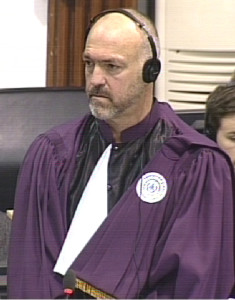
International Co-Prosecutor Nicholas Koumjian
The Co-Prosecutor Nicholas Koumjian said that there was no effect of the witness who had been called by the Supreme Court Chamber. As for the testimony by Sao Van, Mr. Koumjian said that he had only said that the Khmer Rouge cadres should not kill the soldiers below the rank of colonels without Ta Mok’s approval did not mean that they were not to be killed – zone leaders were to be asked before killings took place.
As for Sam Sithy, he said that the Prosecution considered his testimony extremely consistent. He had witnessed how his mother and other people had been called, while he had heard his father being shot. Moreover, about Toit Thoerun, he had talked about how former Lon Nol soldiers were tricked to identify themselves and subsequently been killed. The additional evidence therefore corroborated the evidence that there had been a policy to kill Lon Nol soldiers.
Judge Ya Narin said that the Trial Chamber had based itself on thousands of pages of evidence of various types and asked the Khieu Samphan Defense Team to what extent the methods of tendering into evidence impacted the judgment. Ms. Guissé said that they would partially deal with the question tomorrow in the section on individual responsibility. Moreover, the question was “not so much” what the Chamber relied upon, but rather “what they did with the evidence”.
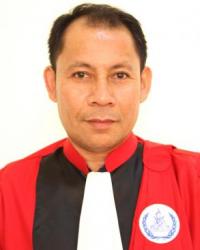
Judge Ya Narin (ECCC)
For instance, as for the use of coercion vis-à-vis the New People, and for Khieu Samphan’s responsibility for this, the Chamber had held that there was an element of coercion and constraint as evidenced in the ideology after 1975. The Chamber had cited his thesis.[12] She argued that the thesis by Khieu Samphan did not say exactly what the Chamber did. It was far from what the Chamber has presented as CPK and the Chamber had misrepresented the thesis. The question was not about how many footnotes there were, but how these documents were used.
At this point, the President adjourned the hearing for a break. The hearing will resume tomorrow at 9 am.
[1] Paragraph 41 of the Appeal Brief; and testimony of 11 June 2013, at 15:58. Available at http://eccc.gov.kh/sites/default/files/documents/courtdoc/2013-06-27%2012:32/E1_205.1_TR002_20130611_Final_EN_Pub.pdf
[2] E305/12.38R
[3] E189/3/1/7.1.2 at 00893651 and 00893657.
[4] International Criminal Court, Katanga, Minority Opinion by Judge Christine van den Wyngaert, at paragraph 172.
[5] Paragraphs 544 and 545 of the defense appeal brief.
[6] E267/3.
[7] E96/7.
[8] E223/2/8 for Nuon Chea, E208/5 for Khieu Samphan.
[9] F1/3.1.
[10] 03 July 2015, at 15:16.
[11] E275/2/1.3.
[12] Case 002/01, Judgment, at paragraphs 783 and 784.
Featured Image: Khieu Samphan at the Appeal Hearing (ECCC: Flickr)
